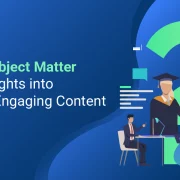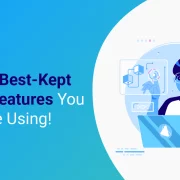
7 Best Online Training Delivery Formats
Summary
This article explores seven effective online training delivery formats, highlighting their benefits and how they can be tailored to meet diverse learning needs in corporate settings.
Earlier, corporate training was entirely dependent on trainers. Experts in the relevant fields would conduct workshops, seminars, and training sessions to meet the organization’s training needs. It was all about creating an interactive classroom experience and offering job aids or manuals to improve employee performance.
But, in today’s technology-driven world, a lot has changed about how a training program is delivered thanks to the advent of digital learning. Research reveals that around 89% of companies in the United States use a learning management system (LMS) for their corporate training.
Accessibility, personalized learning, and cost-effectiveness make eLearning a popular online training delivery format. However, choosing the right delivery method that aligns with your organization’s goals and your employees’ learning needs can be difficult.
To that end, in this article, we’ve covered 7 popular online training delivery formats and how to choose among them.
Choosing the Right Training Delivery Methods
When it comes to selecting a delivery format for your employee training, it is recommended to ask the following questions:
- What results does the training program aim to achieve?
- Who are the learners or the target audience?
- What is your company’s financial situation?
- How much will the delivery method cost per employee?
- What are the required development resources?
- How much time and resources can your company invest?
- What kind of training content is needed to train employees effectively?
The answers to the above-mentioned questions will help you select the right delivery method from the plethora of options available.
To help your organization keep up with the trend in digital learning, we’ve listed below some of the best online corporate training delivery methods.
7 Popular Online Training Delivery Formats for the Virtual Work Environment
1. Virtual Instructor-led Training (VILT)
Unlike a traditional classroom, virtual instructor-led training (VILT) connects learners and instructors via a virtual space. Despite being in different locations, attendees can get trained at the same time through webinars and conferencing software.
In today’s new world of remote learning, VILT is a real boon. It offers great flexibility and convenience to learners regarding how and where they learn.
As there are no hospitality or travel expenses involved, VILT helps in reducing training costs. It can also be combined with collaborative tools like roleplay and discussion boards to keep the human touch intact.
2. eLearning
eLearning is one of the most widely-used training methods delivered via an online learning management system (LMS) or a corporate learning portal. It is known for creating better engagement, personalized learning experiences, and retention than traditional training.
The global eLearning market was worth over $315 billion in 2021 and has an expected compound annual growth rate (CAGR) of 20% from 2022 to 2028.
From games, prerecorded videos, and blogs to slideshows, quizzes, and voiceovers, eLearning offers all that it takes to make the content more engaging and interactive for the employees. While instructors can track each employee’s training progress, employees have the flexibility to learn at their own pace.
3. Social Media-based Learning Model
What can be better than social media to reach a wider audience? The ever-growing power of social media is indisputable.
It’s no wonder that L&D teams are using social media platforms like Twitter, Facebook, and Instagram as a new training delivery method. The training content is broken down into smaller episodes, each personalized to meet specific training goals.
Such training programs promote collaboration and teamwork. If social media is an integral part of your organization, then this learning model can enhance your staff’s familiarity with essential internal and external methods of communication.
4. Video Training
Video modules have been used by educators for decades. But training videos, in today’s high-tech world, are more engaging and accessible than ever before.
Many corporations believe that video learning is an effective way to engage employees. After all, who doesn’t like graphics-based delivery?
In addition to interesting visuals and storytelling, videos also offer great versatility. They are not restricted to learn-by-example scenarios anymore.
Video training now offers first-person style narratives or “choose your own adventure.” They allow employees to navigate their learning according to their knowledge and seek feedback directly from experts when required.
5. Microlearning
Microlearning videos are one of the most popular online training delivery formats. Most adults have an attention span of around 8 to 10 minutes. Here’s where microlearning comes in handy.
This method breaks down the learning content into shorter topics or sections using videos. Each video revolves around a single topic, thereby making it easier for learners to effectively retain information.
It also offers them great flexibility as they are not required to complete the session in one go. Learners can schedule one-on-one sessions from their living room or a café whenever they are willing to.
6. Blended Learning
Blended learning is an excellent combination of high-tech eLearning and traditional face-to-face classroom training. This method engages both traditional learners and learners who are comfortable with computer-based training.
It also enables employees to learn in their leisure time, playing videos, games, tutorials, and quizzes from their tablet, laptop, or smartphone.
Another advantage of this method is that it enables trainers to assign scenario-based or skill-building tasks outside the classroom. This gives them an opportunity to prepare for the class and receive feedback from their trainers and peers.
7. Mobile Learning
As the name suggests, mobile learning or mLearning includes content that is optimized to be displayed on smartphones or mobile devices. We live in a dynamic workplace where the needs of remote learners must be catered to, and mobile learning is one of the best ways to go.
Popularly known as “learning on the go,” it is a self-paced digital training available to learners across multiple mobile devices (smartphones/tablets). This enables employees to access the required content from the comfort of their homes.
From how-to videos and bite-sized modules to podcasts, and social learning, the learning content is delivered in a variety of interactive formats.
Wrapping Up
Selecting the right training delivery format requires attention to training outcomes, training needs, access to technology, and budget. With the changing training trends in a new virtual workforce, it can be difficult to identify which delivery method to implement.
However, carefully developing your online training experience with these 7 delivery formats in mind can help you take your employee experience to the next level.
Explore the corporate training solutions offered by Hurix Digital that help you design the training that meets your organization’s requirements. Contact our team of experienced professionals to learn more about how we can support your training needs, learning goals, and budget.

A highly enthusiastic and motivated sales professional with over twenty five years of experience in solution selling of training-related applications and services. Maintains an assertive and dynamic style that generates results. Ability to establish long-term relationships with clients built on trust, quality of service and strategic vision. Specializes in financial services, higher ed, publishing and government in the areas of learning and development.




